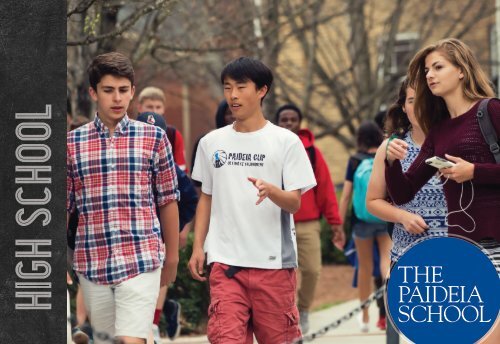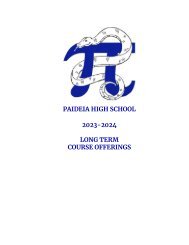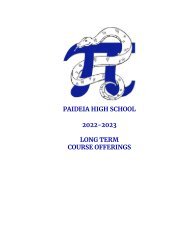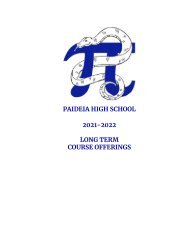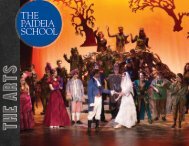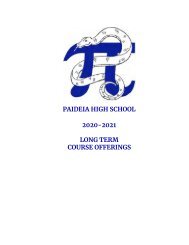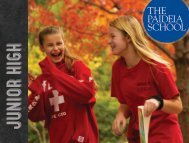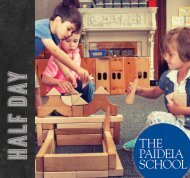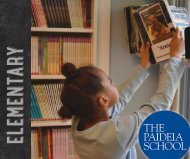HS viewbook
You also want an ePaper? Increase the reach of your titles
YUMPU automatically turns print PDFs into web optimized ePapers that Google loves.
Paideia is an unusual name for a school. It is often<br />
mispronounced, and it may take you a few tries to remember<br />
how to spell it. Our founders chose the name back in 1970, but<br />
the word has its origin in ancient Greece and describes a way<br />
of educating a young person by an entire community’s pursuit<br />
of a series of educational goals. We believe the founders chose<br />
wisely and that the school has lived up to its name.
As a student here, you will be<br />
encouraged to pursue each<br />
goal enthusiastically. Chase it.<br />
Chasing doesn’t always mean you<br />
completely get there, but rather<br />
that you make continual progress.<br />
It means questioning as well as<br />
answering.<br />
The school’s name also suggests<br />
that you don’t have to pursue<br />
a goal on your own. Often the<br />
pursuit is with other students,<br />
teachers, and family. We help each<br />
other learn, discover our talents<br />
and skills, and better understand<br />
our world and ourselves. We<br />
understand that learning will<br />
continue throughout your life, so<br />
we will educate you broadly and<br />
deeply and provide you with the<br />
skills to continue to learn long<br />
after you’ve left Paideia.
Paideia High School Culture<br />
Long before formal schools existed, people<br />
argued about what makes a good education.<br />
There are many definitions and they are<br />
not, of course, all consistent; it also follows<br />
that a good education for one person might<br />
not be equally valuable to another. We<br />
do not pretend that Paideia has resolved<br />
this debate, but we do emphasize what<br />
we believe are important characteristics<br />
of education at our school. One involves<br />
challenge: the challenge of demanding<br />
academics, rich opportunities in the arts<br />
and athletics, and learning to be an engaged<br />
member of a community. Another is the<br />
development of self-knowledge, interests,<br />
identity, and perspective as well as the<br />
ability to speak up. This is best done in an<br />
environment that is personal and has lots<br />
of things going on. A third characteristic of<br />
education at Paideia is that it is much more<br />
individualized than at most high schools.<br />
The academic program of a school is<br />
a mixture of requirements, offerings,<br />
expectations, and choices. At Paideia the<br />
program can at first look imposing because<br />
there is so much to do, but all students<br />
have advisors who help them navigate<br />
and make full use of the curriculum. While<br />
there are academic requirements set by<br />
the school, as well as courses of study<br />
strongly recommended by colleges, hardly<br />
anyone proceeds through the high school<br />
in the same way. Students bring to school<br />
varying backgrounds, abilities, and interests.<br />
The school does whatever possible to<br />
match those interests and abilities with the<br />
appropriate course of study. At Paideia<br />
students are greeted and known as<br />
individuals.<br />
A Culture of Diversity<br />
Paideia prides itself on its diversity of<br />
ethnic groups, interests, and opinions. We<br />
live in a diverse society, multicultural and<br />
varied in opinion and lifestyle. We want a<br />
school population that reflects that larger<br />
society. Not everyone comes from the<br />
same neighborhood or cultural background,<br />
has the same ideas, or has the same goals.<br />
Paideia is a liberal environment in the<br />
classical sense that liberal means openminded<br />
and respectful of other points of<br />
view. We believe in equality, and we work<br />
hard to practice it. The environment of the<br />
school discourages peer pressure, pecking<br />
orders, and the herd instinct.<br />
A Culture of Learning<br />
Visitors to the school are often surprised to<br />
discover that students call their teachers by<br />
their first names. Calling a teacher “Eddy”<br />
or “Sarah” does not mean that he or she<br />
is a best friend or that a student has the<br />
same responsibilities or authority in the<br />
school that the teacher does. Being on a<br />
first name basis with teachers is symbolic<br />
of the school’s desire for well-developed,<br />
comfortable relationships between<br />
teachers and students. These relationships<br />
encourage learning, taking intellectual risks,<br />
and not being afraid to ask for help. Serious<br />
learning is hard work, but it need not be<br />
impersonal. Teaching and learning should<br />
be cooperative, not adversarial.
A Culture of Trust<br />
More important than how students and<br />
teachers address each other is how they<br />
treat each other. Teachers expect students<br />
to do well and try hard. We want students<br />
to become responsible for themselves,<br />
personally and educationally. There’s no<br />
better way to do that than to trust them<br />
with choices and freedom that almost all<br />
can handle if given the chance.<br />
An example of the culture of trust is<br />
students’ choosing to leave their belongings<br />
in unlocked lockers and common spaces.<br />
Another example is that students do not<br />
need permission to eat lunch anywhere<br />
on campus. There are no hall passes to<br />
the restroom nor systems of demerits<br />
and detention. People make mistakes, of<br />
course, but most are easily remedied in<br />
straightforward conversation.<br />
The school does not differ from most other<br />
strong high schools in certain areas of<br />
curriculum as much as it does in how it feels<br />
to be here. The unusual degree of respect<br />
and trust is much like the trust and freedom<br />
typically enjoyed by students and faculty in<br />
colleges and universities.
Teachers at Paideia<br />
The strongest programs at Paideia do not come<br />
from a national standardized curriculum or<br />
the dictates of an administrative committee or<br />
the board of trustees, but spring instead from<br />
the entrepreneurial energy and passions of<br />
teachers. Teachers draw on their knowledge<br />
and experiences as well as their own creativity.<br />
There is no one profile of teacher at Paideia.<br />
Some began their careers here, others came<br />
from public schools; a few taught previously<br />
in college, and some left other professions to<br />
become teachers. Paideia does not expect<br />
Teaching is an art
all teachers to teach in the same way. Some smile<br />
and hug a lot; others are more reserved. All, and<br />
this is where the differences merge, are excited by<br />
learning and love to teach.<br />
Paideia teachers are flexible in approach but<br />
dedicated to getting the best out of every student.<br />
Teachers provide a demanding intellectual<br />
environment, demanding not in the sense of being<br />
strict, competitive, or exhausting, but by stretching<br />
and challenging students to do things they were<br />
previously unable to do. Teachers want students<br />
to participate actively in their classes by asking<br />
questions, sharing ideas, and listening to others.<br />
Because not all learning comes easily, the faculty is<br />
willing to offer extra help to make it possible for a<br />
student to succeed.
“I chalk up a great deal of my adult<br />
accomplishments to Catharine’s<br />
tutelage. During my two-year stint as<br />
a columnist for my college newspaper,<br />
occasionally I would be asked<br />
where I learned to write. Last time<br />
that question was posed to me, I<br />
responded with the truest, humblest<br />
answer I could muster, that being, “I’m<br />
not a writer, I just have an extremely<br />
positive, healthy relationship with<br />
English.” Witnessing Catharine’s joyous<br />
relationship with the language gave me<br />
the confidence to take the leap of faith,<br />
one I continue to take on a daily basis.”<br />
Paideia high school alum and<br />
professional writer<br />
Academic Workload and Support<br />
Most prospective students want to know variety of evaluations so that students can<br />
about the typical academic workload.<br />
demonstrate knowledge and competence<br />
Because people go about their work in<br />
in differing ways. Tests usually ask for<br />
different ways, the average amount of<br />
analysis and interpretation of information,<br />
homework time varies. Some students are not simply the repetition of facts. Teachers<br />
more efficient and well organized; others expect their students to engage with the<br />
take longer. Academic schedules vary.<br />
material and be able to use it. Intellectual<br />
development, like physical development,<br />
There are hard courses and medium courses requires activity. There is a minimum of rote<br />
but very few easy courses. While not many learning or providing perfunctory answers<br />
generalizations apply to the workload at to the questions at the end of a chapter.<br />
Paideia, it is safe to say that compared to<br />
most of their peers in other schools, Paideia<br />
students are expected to do more, and they With a support system of classroom<br />
do.<br />
teachers, advisors, counselors, learning<br />
specialists, and administrators, students<br />
Of greater significance than the amount of who expend the necessary effort find that<br />
schoolwork is the kind of work assigned. it is not difficult to succeed. Part of the very<br />
It is here that Paideia differs from most definition of success involves the ability to<br />
other high schools, public or private.<br />
work hard. Figuring out what it means to<br />
At Paideia, students focus on writing,<br />
work hard, and then practicing it and getting<br />
and some assignments are spread over<br />
better at working hard are worthy goals for<br />
several weeks. Courses often include a students of any age.
Long and Short Terms<br />
The school year is divided into four terms.<br />
Terms I and II are called “long terms” and<br />
are structured like most high schools’ fall<br />
and spring semesters; Term I lasts 17 weeks,<br />
Term II 14 weeks. Terms A and B are “short<br />
terms” and last four weeks. Term A is in<br />
January and Term B is in May and early<br />
June.<br />
During the long terms there are six class<br />
periods and most students take five<br />
academic classes. We have a modified block<br />
schedule where classes meet three times a<br />
week for 50 minutes and once a week for<br />
100 minutes. Many students use the sixth<br />
time slot for music, drama, art, journalism,<br />
or yearbook; others elect a study hall. There<br />
is something, or more than some things,<br />
for everybody. Juniors and seniors have<br />
a greater choice of electives during long<br />
terms than freshmen and sophomores, and<br />
they are often in classes together.<br />
Short terms, depending on the course, draw<br />
students from all four years of high school.<br />
These courses might be in art, drama,<br />
science electives, physical education,<br />
interdisciplinary academic courses, or<br />
community service internships. Students<br />
and faculty love short terms because longer<br />
class times provide greater opportunity for<br />
a debate, a movie, a guest speaker, or a field<br />
trip. Having two short terms during the year<br />
also changes the biorhythms of the school—<br />
less stress, more opportunity for studentdirected<br />
learning, and chances to pursue a<br />
particular subject in greater depth.<br />
Short-term courses allow students to<br />
investigate academic areas and pursue<br />
interests that most high school students<br />
don’t get to explore during the long-term<br />
semesters. A student in Paideia’s longterm<br />
orchestra program, for example,<br />
might choose to take a course in musical<br />
composition or take a course devoted<br />
to one author or historical event during<br />
short term. Short-term courses can be<br />
the beginning of a student’s enduring<br />
enthusiasm for a subject or craft. Some<br />
students propose and co-teach a short-term<br />
class with a faculty member.<br />
The short terms are an effective method<br />
for the adults in the Paideia community to<br />
share their varied interests and expertise<br />
with students. A history teacher, long<br />
involved in the Native American rights<br />
movement, teaches Native American<br />
Studies. A math teacher with a penchant for<br />
politics teaches a course on the American<br />
presidential election process. A science<br />
teacher from Scandinavia teaches about the<br />
games of the Vikings. An English teacher<br />
delves deeper into one person’s American<br />
experience by focusing on one novel, Ralph<br />
Ellison’s Invisible Man.
“We aren’t trying to impose our knowledge or beliefs on our<br />
students; we are helping them realize parts of themselves<br />
that were always there but just needed a little nudge. And<br />
what a cool responsibility: to help people bring out in<br />
themselves what will make them into their best selves.”<br />
Paideia Science Teacher and Alum<br />
STEAM and<br />
Urban Agriculture<br />
In addition to our traditional science classes, high school<br />
students can take MAKE: Mechanics to learn about building<br />
things with their hands, tools, and 3D printers. We offer robotics<br />
as a long-term class and an after-school club. Other clubs<br />
include Rocketry, Makers Club, Urban Agriculture, and a girlsonly<br />
coding club. Our many short-term STEAM classes vary<br />
from year to year. Recent offerings have included Video Game<br />
Design, Science Olympiad, Virtual Reality, and Web Design.<br />
Many of our STEAM projects draw on Paideia’s unique urban<br />
agriculture program which features mini-farms and gardens that<br />
not only give students hands-on experiences with agricultural<br />
and environmental practices, but also provide hundreds of<br />
pounds of food annually to local food banks.
» Activities<br />
The high school at Paideia is relatively small with about 440 students, just over a hundred in each graduating class. The school is large enough to<br />
support a full range of classes and activities and also an impressive diversity of students. It is small enough so that most people get to do what<br />
they want to do—sing in the chorus, play a sport, and sample a large part of what is available. There are different groups, often centering on<br />
extracurricular interests, and because most students participate in several activities, all of these groups are inclusive, encouraging participation<br />
and discouraging cliques.<br />
» Sports<br />
Athletics are an important part of life at Paideia. Our athletic program emphasizes participation, competitiveness, commitment, and quality<br />
instruction. Whether you play on Varsity, Junior Varsity, or PiLeague intramurals, there is a place for you if you choose to participate. Varsity<br />
sports include baseball, basketball, cross-country, golf, soccer, softball, swimming, tennis, track, volleyball, and Ultimate. More than half of<br />
Paideia students participate in interscholastic sports. Coaches emphasize physical and mental development, hard work, and perseverance. Our<br />
athletes are routinely recognized for outstanding team spirit and sportsmanship. We don’t always win, but we win more than our share, even<br />
some state championships. Many Paideia graduates continue to play in college.<br />
» Music<br />
Instruction in music is as important and high quality as the academic program. Almost half of the high school either sings in one of the choruses<br />
or plays in the orchestra or jazz ensemble. Paideia students are introduced to sophisticated pieces of music, far more advanced than the typical<br />
high school repertoire. They perform in large ensembles, small quartets, and a cappella groups, and they work with professional coaches who<br />
are part of the instructional staff.<br />
Paideia musicians perform off campus both in Atlanta and in some of the notable music halls in the United States. Each January, high school<br />
students stage a full-scale Broadway musical. Recent musicals include In the Heights, Pippin, and Fiddler on the Roof. Our music curriculum is<br />
designed to help serious students develop their skills, which they often pursue in college and beyond. Music classes are also full of students who<br />
simply want the chance to sing or play an instrument during high school.
» Theater and Film<br />
Paideia offers a comprehensive theater program for students who seek the spotlight, just want to join the cast, or prefer a role behind the<br />
scenes. Students can study drama during long and short terms, and multiple theater performances are staged every year in our two theaters.<br />
Productions range from one-act plays to full-scale dramas, comedies, and musicals. Some plays are complex works of modern drama, and some<br />
are traditional theater favorites. Students perform on stage and also learn the skills needed behind the scenes such as stage lighting, set and<br />
costume design, and playwriting. Students write, direct, and act in films and take courses related to film production during long and short terms.<br />
» Visual Arts<br />
A visit to our campus reveals student art everywhere. Art is an integral part of the intellectual, creative, and emotional expression the school<br />
encourages. Paideia students are highly successful in city, state, and regional juried competitions. Some of our graduates attend the most<br />
renowned art schools in the country. In the spirit of encouraging students to try something new, every high school student can take art, whether<br />
the student is just getting started or is advanced.<br />
» Organizations and Clubs<br />
There are enough extracurricular activities at Paideia for a high school four times its size, too many for one person to do. Students run most<br />
of the clubs or special interest groups. Teachers mentor students on forming and running an organization, which is one of the ways to develop<br />
leadership and active participation. Some of the names and themes of student organizations vary from year to year based on student interest,<br />
but the mainstays include: Volunteer Paideia, yearbook, Green Team, Science Olympiad, Amnesty International, debate, The Forum (newspaper),<br />
math team, Academic Bowl, drama club, Model U.N., foreign language clubs, robotics, and Mock Trial.<br />
Much of the social life on campus is run by the elected Steering Committee, Paideia’s student council. Steering Committee organizes dances,<br />
movie nights, the Thanksgiving feast, and fan vans for away games. It sometimes acts as a conduit of student opinion to the faculty.<br />
Every Monday the entire high school meets in the theater for Monday Morning Meeting. Students run the meetings, and in addition to the club<br />
and team announcements for the week, there are often skits, music, poetry, or promotions for upcoming events. Monday Morning Meetings can<br />
be boisterous and funny, purely informational, or a venue for serious discussion.
Leadership,<br />
Service Learning,<br />
Internships<br />
Paideia offers numerous ways to learn to become a more<br />
effective leader. For example, Peer Leadership is a chance<br />
for seniors to work with ninth graders on issues of academic<br />
and social adjustment to high school life. The friendships<br />
that develop between peer leaders and ninth graders are<br />
an important part of the bonds that tie the school together.<br />
A similar program called Mentorship has juniors and seniors<br />
working with Paideia junior high students.<br />
STUDENTS HAVE:<br />
» volunteered on political campaigns<br />
» installed a community garden for senior<br />
citizens<br />
» packed and delivered meals to people<br />
who are homebound<br />
» removed non-native species in the area<br />
» taught science to elementary students<br />
» facilitated environmental projects within the<br />
school and in the community<br />
Paideia’s high school internship program is part of a schoolwide<br />
initiative designed to strengthen the communitystewardship<br />
ethic and deepen learning through volunteerism<br />
and civic involvement. Students have the opportunity to<br />
investigate pressing issues of social justice through service.<br />
Each student is asked to do sustained work with a nonprofit<br />
that addresses an issue in the community. The service<br />
requirement consists of two different internships, with a 30<br />
hour minimum for each.
College Admissions<br />
Paideia students receive a tremendous<br />
amount of support as they plan for college.<br />
College counseling at Paideia, like the<br />
school itself, is personal and individualized.<br />
While the purpose of learning in high school<br />
is not admission to college, awareness of<br />
the realities (and myths) surrounding college<br />
admissions is important. For a variety of<br />
reasons, Paideia seniors do very well in<br />
this process. By attending an intellectually<br />
demanding school with challenging classes,<br />
most seniors can demonstrate to colleges<br />
that they are capable and serious students.<br />
The good reputation of the school casts a<br />
favorable light on everyone.<br />
Most Paideia students do well on the SAT,<br />
ACT, and other standardized exams. In a<br />
typical year many are named National Merit<br />
or National Achievement semi-finalists and<br />
outstanding participants.<br />
Paideia students also do well in college<br />
admissions because in an environment<br />
rich in activities, issues, and opportunities<br />
for expression, most become involved<br />
and interested and, therefore, more<br />
interesting people. College representatives<br />
frequently tell us that applicants from<br />
Paideia are unusually able to discuss their<br />
thoughts, goals, and activities. This ability<br />
to express oneself well is always valuable,<br />
and it is clearly advantageous in the college<br />
admission process.
All schools are more complicated and complex<br />
than any brochure can summarize. They<br />
have histories, aspirations, opportunities<br />
and challenges, plus a cast of characters.<br />
Different schools also have different cultures,<br />
which often make a tremendous difference<br />
in what it feels like for a student to be there.<br />
Is the place encouraging or adversarial? Are<br />
students known personally or seen instead as a<br />
stereotype? Is there laughter or do most people<br />
grumble through the day? Culture is a powerful<br />
characteristic of most organizations, schools<br />
included.<br />
If these pages succeed in raising more questions in your mind,<br />
and you want to find out more, here’s what to do next:<br />
FIRST, continue to read. Many of your questions may be<br />
answered on the school’s web site,<br />
www.paideiaschool.org<br />
SECOND, arrange for a visit. Sit in on classes and talk to<br />
students and teachers. Come to a basketball game or a<br />
concert. You’ll probably have more answers, but also another<br />
level of questions. Seek out answers to them.<br />
THIRD, think about what you’ve learned and whether you<br />
would enjoy and do well at a school like Paideia.<br />
We welcome your interest.<br />
What is more, a good school evolves and its<br />
agenda grows every year. Over the years the<br />
high school at Paideia has grown in size and<br />
depth, in the diversity of students, and in the<br />
breadth of faculty talent. The currency of<br />
schooling ought to be growth because individual<br />
student growth is best done in places that<br />
themselves are growing. We think much at<br />
Paideia exemplifies this dynamism.
The Paideia School serves families with children<br />
ages three through eighteen. The school actively seeks racial, cultural,<br />
and economic diversity in its student body. Paideia is nonsectarian.<br />
The meaning of the ancient Greek word paideia (pie-day-uh) has<br />
changed throughout the centuries so that it has no literal translation.<br />
Rather, it reflects the conscious pursuit of a series of educational goals<br />
by a community. It conveys the concept of a child’s total education:<br />
intellectual, artistic and social.<br />
Paideia is different from most other schools and cannot be accurately<br />
categorized by a single philosophy or approach. We encourage you to<br />
find out more about Paideia by attending a prospective parent meeting,<br />
by talking to students and parents involved at the school, by touring, by<br />
reading our website, and by asking questions.<br />
We welcome your interest.<br />
Photo Credits:<br />
Danny Lee Photography,<br />
Kemi Griffin, and the Paideia yearbook staff<br />
Paideia does not discriminate on the basis of race, religion, ethnic<br />
group, gender, or sexual orientation.<br />
PAIDEIASCHOOL.ORG<br />
© 2018. The Paideia School. All rights reserved.


